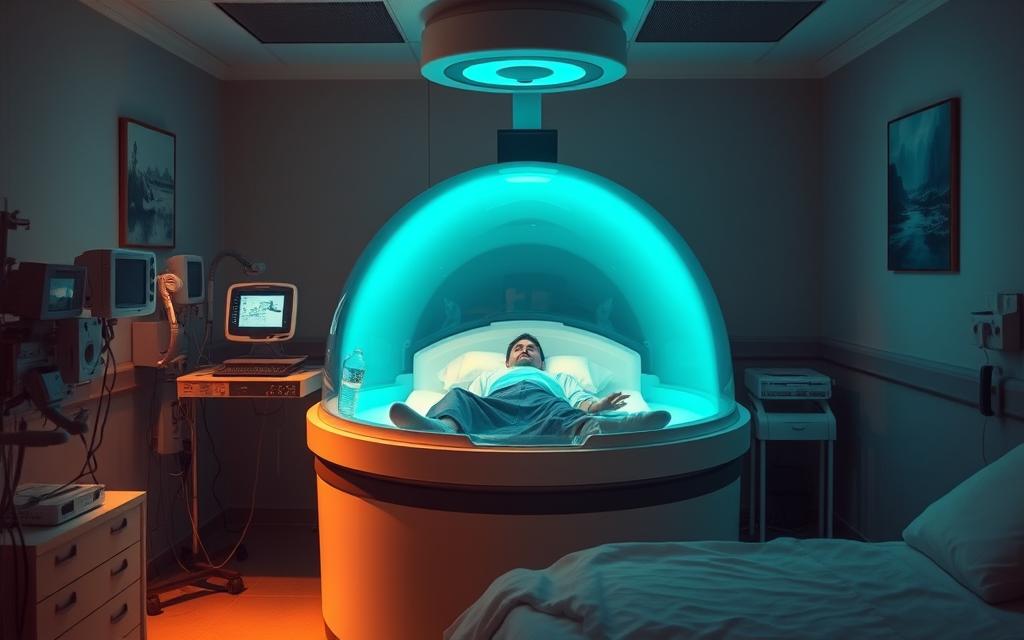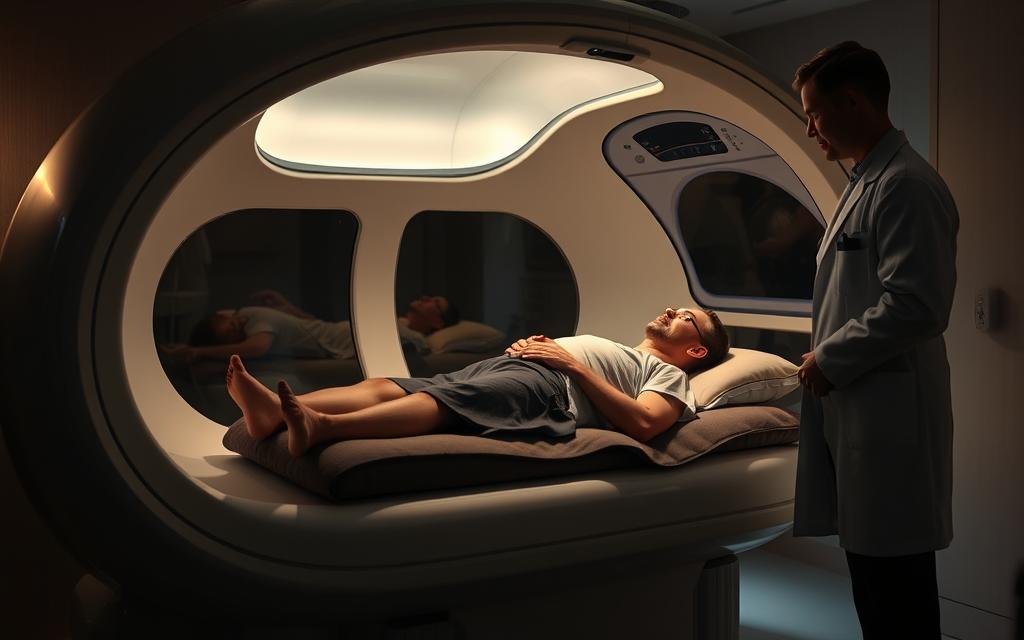Hyperbaric Oxygen Therapy for Erectile Dysfunction: Benefits & Results Explained
Hyperbaric oxygen therapy (HBOT) has emerged as a promising treatment for erectile dysfunction (ED), a condition affecting millions of men worldwide. By delivering high concentrations of oxygen to the body, HBOT aims to improve blood flow and promote healing, potentially restoring sexual function.
Men’s sexual health is a critical aspect of overall well-being, and HBOT offers a non-invasive approach to addressing ED. Research into the benefits and results of hyperbaric oxygen therapy for erectile dysfunction treatment is ongoing, but initial findings are encouraging.
As we explore the potential of HBOT in treating ED, it’s essential to understand the therapy’s underlying mechanisms and the impact it can have on men’s sexual health.
Understanding Erectile Dysfunction: Causes and Prevalence
Understanding the causes and prevalence of erectile dysfunction is crucial for developing effective treatment strategies. Erectile dysfunction (ED) is a condition that affects a significant number of men worldwide, causing distress and impacting their quality of life.
Common Causes of Erectile Dysfunction
Erectile dysfunction can result from a variety of factors, including vascular diseases, diabetes, and neurological disorders. Lifestyle factors such as smoking, excessive alcohol consumption, and lack of physical activity also play a significant role. Additionally, psychological factors like stress, anxiety, and depression can contribute to ED.
Who Is Affected by ED?
Erectile dysfunction can affect men of various ages, but its prevalence increases with age. Studies have shown that approximately 40% of men at the age of 40 experience some form of ED, with this number significantly increasing as men get older. Other risk factors include having a history of cardiovascular disease, being overweight or obese, and having high blood pressure.
Impact on Quality of Life
The impact of erectile dysfunction on a man’s quality of life should not be underestimated. ED can lead to reduced self-esteem, relationship problems, and even depression. Effective treatment options are essential to mitigate these effects and improve overall well-being.
By understanding the causes and prevalence of erectile dysfunction, healthcare providers can develop targeted treatment plans that address the specific needs of each patient.
The Connection Between Fiber and Erectile Dysfunction
Emerging research suggests that dietary fiber plays a crucial role in maintaining vascular health, which is closely linked to erectile dysfunction.
Erectile dysfunction (ED) is a condition that affects not only the quality of life but also the self-esteem of millions of men worldwide. While various factors contribute to ED, including vascular health and hormonal balance, dietary adjustments offer a promising avenue for improvement.

Vascular Health Impacts
Dietary fiber has been shown to positively impact vascular health by improving blood flow and reducing inflammation. A high-fiber diet can help mitigate some of the vascular-related causes of erectile dysfunction.
Hormonal Balance
Fiber also plays a role in maintaining hormonal balance, which is crucial for sexual health. A diet rich in fiber can help regulate blood sugar levels and support the body’s natural hormonal equilibrium.
Best Fiber Sources for Men’s Sexual Health
Men can benefit from a variety of fiber-rich foods, including fruits, vegetables, whole grains, and legumes. Incorporating these foods into one’s diet can be a simple yet effective way to support sexual health.
Soluble vs. Insoluble Fiber Benefits
| Fiber Type | Benefits | Food Sources |
|---|---|---|
| Soluble Fiber | Lowers cholesterol, regulates blood sugar | Oats, barley, fruits, vegetables |
| Insoluble Fiber | Promotes regular bowel movements, prevents constipation | Whole grains, nuts, seeds, vegetables |
Daily Recommended Intake
The daily recommended intake of fiber varies by age and sex, but generally, men are advised to consume around 30 grams per day. A gradual increase in fiber intake, accompanied by adequate hydration, can help minimize potential side effects.
What Is Hyperbaric Oxygen Therapy?
For those unfamiliar with the term, hyperbaric oxygen therapy is a non-invasive procedure that leverages oxygen and pressure to promote recovery. It involves breathing pure oxygen in a pressurized chamber, which can enhance the body’s natural healing processes.
The Science Behind HBOT
The principle behind HBOT is straightforward: by increasing the amount of oxygen in the blood, it promotes healing and reduces inflammation. When the body is subjected to higher atmospheric pressures, the lungs can absorb more oxygen, which is then transported to various parts of the body, facilitating repair and rejuvenation.
Oxygen-rich blood can help in the recovery of damaged tissues, making HBOT an effective treatment for various medical conditions. The therapy is based on the concept that increased oxygen availability can enhance the body’s natural healing mechanisms.
Traditional Applications of Hyperbaric Therapy
Originally, HBOT was used to treat decompression sickness in divers. Over time, its applications have expanded to include the treatment of wounds, carbon monoxide poisoning, and certain types of infections.
- Treatment of non-healing wounds
- Carbon monoxide poisoning
- Decompression sickness
- Certain infections
HBOT Equipment and Treatment Settings
The equipment used for HBOT includes a hyperbaric chamber, where patients breathe pure oxygen. These chambers can be monoplace (for one person) or multiplace (for multiple people).
Treatment settings vary, but typically, patients undergo sessions that can last anywhere from 60 to 120 minutes, depending on the condition being treated. The number of sessions required is determined based on the patient’s specific needs and the severity of their condition.
How Hyperbaric Oxygen Therapy Helps with ED
Hyperbaric Oxygen Therapy (HBOT) has emerged as a promising treatment for Erectile Dysfunction (ED), offering new hope for men seeking relief. This therapy involves breathing pure oxygen in a pressurized chamber, which enhances the body’s natural healing processes.

Improving Blood Flow and Vascular Function
One of the primary ways HBOT helps with ED is by improving blood flow and vascular function. The increased oxygen levels delivered to the body’s tissues help to repair and regenerate damaged blood vessels, enhancing overall vascular health. This improvement in blood flow is crucial for achieving and maintaining erections.
Tissue Regeneration Benefits
HBOT also promotes tissue regeneration, which is vital for addressing the underlying causes of ED. By stimulating the release of growth factors and stem cells, HBOT encourages the repair of damaged tissues in the penis, leading to improved erectile function.
Comparing HBOT to Traditional ED Treatments
When considering treatment options for ED, it’s essential to compare HBOT to traditional methods. Unlike conventional treatments that often rely on medication, HBOT offers a non-invasive approach with potentially longer-lasting benefits.
Medication vs. HBOT Approaches
Traditional ED treatments frequently involve the use of oral medications or other pharmaceutical interventions. In contrast, HBOT provides a drug-free alternative that targets the root causes of ED, such as poor blood flow and tissue damage. This difference in approach can make HBOT an attractive option for those seeking a more holistic solution.
Timeline for Seeing Results
The timeline for observing results with HBOT can vary depending on the individual and the severity of their ED. However, many men report noticeable improvements within a few weeks of starting treatment. A typical treatment course involves multiple sessions, and the effects can be cumulative, leading to enhanced erectile function over time.
Research and Clinical Results of HBOT for Erectile Dysfunction
HBOT has emerged as a promising treatment option for erectile dysfunction, backed by a growing body of clinical evidence. This therapy involves breathing pure oxygen in a pressurized room or chamber. In the context of ED, HBOT is believed to improve blood flow and promote healing, potentially leading to improved erectile function.
Key Studies and Their Findings
Several studies have investigated the efficacy of HBOT in treating ED. A notable study published in the Journal of Sexual Medicine found that men with ED who underwent HBOT experienced significant improvements in erectile function compared to those who received a placebo.
Key findings from recent research include:
- Improved vascular function
- Enhanced erectile function
- Positive impact on quality of life
Another study highlighted in the European Urology Journal demonstrated that HBOT not only improved erectile function but also had a positive effect on the psychological well-being of patients.
Success Rates and Patient Experiences
Success rates for HBOT in treating ED vary across studies, but overall, the therapy has shown promising results. Patient experiences are generally positive, with many reporting improved erectile function and overall satisfaction with the treatment.
| Study | Success Rate | Patient Satisfaction |
|---|---|---|
| Journal of Sexual Medicine | 65% | 80% |
| European Urology Journal | 70% | 85% |
Potential Side Effects and Considerations
While HBOT is generally considered safe, potential side effects include ear barotrauma, sinus pressure, and oxygen toxicity. Certain individuals should avoid HBOT, including those with untreated pneumothorax or severe chronic obstructive pulmonary disease (COPD).
Who Should Avoid HBOT
Individuals with the following conditions should consult their healthcare provider before undergoing HBOT:
- Untreated pneumothorax
- Severe COPD
- Certain ear or sinus conditions
Cost and Insurance Coverage
The cost of HBOT for ED can vary widely depending on the treatment center, location, and number of sessions required. Insurance coverage also varies, with some providers covering HBOT for certain medical conditions but not others.
It’s essential for individuals considering HBOT for ED to:
- Consult with a healthcare provider
- Check insurance coverage
- Understand the potential costs involved
Conclusion: Creating a Comprehensive ED Management Plan
Effective management of erectile dysfunction requires a multifaceted approach that incorporates various treatment modalities and lifestyle adjustments. Hyperbaric oxygen therapy (HBOT) has emerged as a promising treatment option, enhancing blood flow and promoting tissue regeneration.
A comprehensive ED management plan should consider dietary changes, such as increasing fiber intake, alongside HBOT and other treatments. This holistic strategy can lead to improved vascular health, hormonal balance, and overall sexual well-being.
By integrating HBOT into a comprehensive treatment plan, individuals can potentially achieve better outcomes and improved quality of life. It’s essential to consult with a healthcare professional to determine the most effective ED management plan tailored to individual needs.
